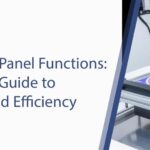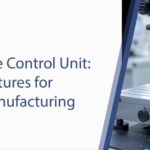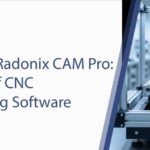Every marvel of modern engineering, from a precision-machined watch component to a massive aerospace structural rib, begins its life not as a piece of metal, but as an idea.
The journey from a digital concept on a screen to a physical, tangible object is paved by a sophisticated ecosystem of software.
This is the world of CNC machine programming—a process that is less about a single program and more about a seamless workflow between different types of specialized software.
Understanding this digital toolpath is essential for anyone in the manufacturing space.
It’s the key to unlocking efficiency, enabling complex designs, and ensuring flawless final parts. But what are these different types of software? How do they work together? And what is the final, critical link that translates all this digital planning into precise, physical motion?
As a global leader in the development of intelligent control systems that form this final link, Radonix is deeply invested in demystifying the entire process.
This comprehensive guide will walk you through the complete CNC programming software workflow, from the initial design blueprint to the final machine execution, revealing how each stage contributes to a perfect result.
The Three Pillars of CNC machine Programming: CAD, CAM, and Control
To grasp CNC programming, it’s best to think of it not as one step, but as a three-stage workflow.Each stage has its own specialized software and a distinct purpose.
A simple analogy is building a house:
- CAD (Computer-Aided Design): This is the architect’s blueprint. It’s where the design of the final part is created in perfect detail, defining its shape, size, and geometry.
- CAM (Computer-Aided Manufacturing): This is the construction manager’s strategic plan. It takes the architect’s blueprint and creates a step-by-step set of instructions—which tools to use, the path they should take, and how fast they should move—to build the house.
- Control Software: This is the foreman on the construction site. It takes the detailed plan and gives the direct, real-time commands to the workers (the machine’s motors) to execute the plan precisely and safely.
Let’s break down each of these critical pillars.
Pillar 1: CAD (Computer-Aided Design) – The Birth of the Idea
Everything starts with a design. CAD software is the digital drafting table where engineers and designers create a precise 2D or 3D model of the part they want to manufacture.
What is CAD?
CAD software allows users to draw, model, and document component and assembly designs in a digital environment. It replaces manual drafting with an automated process, allowing for incredible complexity, easy revisions, and perfect accuracy.
Key Functions of CAD Software
- 2D Drafting: Creating flat, two-dimensional drawings with precise dimensions, often used for parts to be cut from sheets, like in laser or plasma cutting.
- 3D Modeling: Building a three-dimensional, solid digital representation of the part. This is the most common starting point for CNC milling and turning.
- Assembly Modeling: Digitally combining multiple 3D parts to see how they fit and interact with each other.
- Technical Drawings: Automatically generating the traditional 2D engineering drawings (with dimensions, tolerances, and annotations) from a 3D model.
The Output of CAD
The CAD stage concludes with a digital file that contains a perfect geometric description of the part. This file, however, contains no information about how to manufacture it. It’s simply the blueprint. Common file formats include:
- .STEP (.stp): A rich, universal format for 3D models.
- .IGES (.igs): An older but still widely used universal 3D format.
- .DXF / .DWG: Common formats for 2D drawings.
Popular CAD Software Examples: Autodesk AutoCAD, SolidWorks, Autodesk Fusion 360, CATIA, Inventor, Siemens NX.
Pillar 2: CAM (Computer-Aided Manufacturing) – The Strategic Plan
Once the “what” (the design) is established, the CAM software determines the “how” (the manufacturing process). This is arguably the most complex and strategic part of CNC programming, where the digital model is converted into actionable toolpaths.
What is CAM?
CAM software takes the geometric data from the CAD file and generates the toolpaths and corresponding G-code required to machine the part. It’s a bridge between the virtual design and the physical machine.
The CAM Workflow in Detail:
A CAM programmer performs a series of critical steps:
- Importing the Model: The CAD file (.STEP, .IGES, etc.) is imported into the CAM software.
- Job Setup: The programmer defines the machining environment. This includes setting the size and shape of the raw material (the “stock”) and defining the work coordinate system (WCS), which tells the machine where the X0, Y0, and Z0 origin point is located on the stock.
- Tool Selection: The programmer chooses the specific cutting tools that will be used from a digital tool library. This includes defining their exact dimensions (diameter, length, corner radius) and number.
- Creating Toolpaths (The Strategy): This is the core of CAM. The programmer selects and applies various machining strategies to cut the part. These can include:
- Roughing: Strategies designed to remove large amounts of material as quickly as possible (e.g., Adaptive Clearing, Pocketing).
- Finishing: Strategies that use finer tools and passes to create the final, smooth surface of the part (e.g., Contour, Parallel, Scallop).
- Drilling: Creating holes of various sizes and depths.
- Setting Parameters: For each toolpath, the programmer defines critical cutting parameters, such as spindle speed (how fast the tool spins), feed rate (how fast the tool moves through the material), step-over (how much the tool moves over on each pass), and step-down (the depth of each cut).
- Simulation: Before creating any code, the programmer runs a detailed computer simulation.This powerful feature provides a visual rendering of the entire machining process, allowing the programmer to verify the toolpaths, check for any potential collisions between the tool, holder, and workpiece, and get an accurate estimate of the total cycle time. This prevents costly mistakes and broken tools on the actual machine.
The Final Step in CAM: The Post-Processor
After the simulation is approved, the final step is to “post” the code. The toolpaths created inside the CAM software are generic.
The post-processor is a special translator that converts these generic toolpaths into the specific G-code dialect that a particular CNC controller understands.
Every controller brand can have slight variations in its G-code requirements.
Therefore, you need to select the correct post-processor for your machine—for example, a “Radonix 3-Axis Mill” post-processor—to generate a compatible G-code file (usually with a .nc or .tap extension).
Popular CAM Software Examples: Mastercam, Autodesk PowerMill, HSM, Fusion 360 (which has integrated CAM), SolidCAM, GibbsCAM, SprutCAM.
Pillar 3: Control Software – The Flawless Execution
The G-code file generated by the CAM software is the final set of instructions.
But these instructions are just a text file. They are useless without the third and final pillar: the control software.
This is the real-time operating system of the CNC machine, and it’s where Radonix’s expertise comes to the forefront.
What is Control Software?
The control software is the application that resides on the CNC controller.
It loads the G-code program, provides the operator with an interface to manage and monitor the job, and, most importantly, sends the precisely timed electrical signals to the machine’s motors and systems to execute the program.
While CAD and CAM software can run on any standard office PC, control software has a much more demanding job. It must operate in a “hard real-time” environment, meaning it has to execute commands with absolute, deterministic timing. Any delay or “jitter” can ruin a part.
Beyond Simple Execution: The Radonix Intelligent Control Platform
This is where a world-class controller and its software make all the difference. The Radonix platform isn’t just a G-code interpreter; it’s an intelligent command center designed for maximum reliability, performance, and usability.
- Robust Real-Time Environment: A standard PC with Windows is not a real-time system. That’s why the Radonix solution combines our intuitive software with dedicated, high-performance motion control cards. This hardware creates the stable, jitter-free environment necessary to translate G-code into perfectly smooth and accurate motion.
- Advanced Visualization and HMI: A raw G-code file is a long, intimidating list of coordinates and codes. The Radonix control software presents this information in a user-friendly, graphical interface. Operators can see a visual representation of the toolpath, monitor the machine’s position in real-time, and easily manage program flow. This drastically reduces the chance of operator error.
- In-Process Control and Overrides: Manufacturing isn’t always predictable. A tool might start to chatter, or a material might be harder than expected. Radonix software gives the operator real-time control to override the programmed feed rates and spindle speeds, allowing them to fine-tune the cutting process on the fly for a better result.
- Seamless Integration: Radonix controllers are designed to be the perfect final link in the CAD/CAM chain. With correctly configured post-processors, our systems flawlessly interpret the standard G-code produced by any major CAM package, making it easy to integrate a Radonix-controlled machine into any existing programming workflow.
- Integrated PLC Logic: Our software includes a powerful, integrated PLC (Programmable Logic Controller) interface. This allows for easy management of all machine inputs and outputs—coolant, tool changers, probes, safety doors—without needing separate, complex hardware.
The Complete CNC Programming Workflow in Action
Let’s tie it all together with a practical example: making a simple part.
- Concept to CAD: An engineer designs a custom aluminum mounting bracket in SolidWorks. They finalize the 3D model with all the correct holes and dimensions and save it as a .STEP file.
- Strategy to CAM: A CAM programmer imports the .STEP file into Mastercam. They set up the aluminum stock, select a 1/2″ end mill for roughing and a 1/4″ end mill for finishing, and create the necessary pocketing and contouring toolpaths. They run a full simulation to verify the process. Satisfied, they use the “Radonix 3-Axis” post-processor to generate a file named BRACKET_V1.nc.
- Execution with Control: The machine operator transfers BRACKET_V1.nc to their Radonix-controlled milling machine via the network. They load the file into the Radonix control software. The graphical display shows them the toolpath overlaid on the part shape. The operator secures the aluminum block in the vise, uses the machine’s handwheel (MPG) to precisely set the work zero, and presses the “Cycle Start” button on the control panel.
- Flawless Result: The Radonix controller takes over, reading each line of G-code and commanding the machine’s servo motors with perfect precision. The operator watches the part being machined, confident that the software is executing the plan flawlessly, resulting in a finished bracket that perfectly matches the original CAD design.
Conclusion
CNC machine programming is a symphony in three movements: CAD, CAM, and Control. Each part is essential, and they must work in perfect harmony.
The CAD software creates the beautiful music sheet, and the CAM software writes the detailed notes and tempo for each instrument.
But it is the Control software—the conductor—that brings the music to life.
It reads the score, cues each section, and ensures that every note is played with perfect timing and precision. A brilliant plan is only as good as its execution.
In the world of manufacturing, your designs deserve nothing less than flawless execution.
The Radonix intelligent control platform provides the robust, precise, and user-friendly execution needed to turn your digital designs into physical reality, ensuring every part you make is a masterpiece.
Ready to ensure your manufacturing process has the best conductor on the podium?
Contact Radonix today to learn how our advanced control software and hardware can become the reliable heart of your production workflow.
Contact Us:
- E-Mail: info@radonix.com
- Phone: +90 (553) 920 5500








